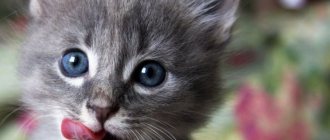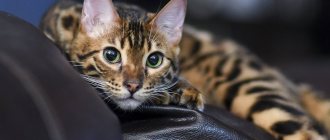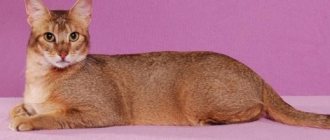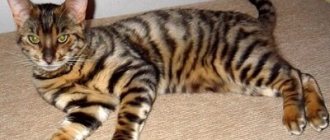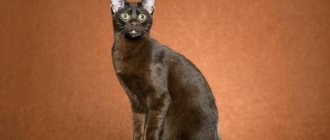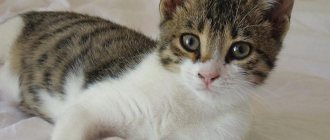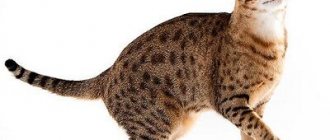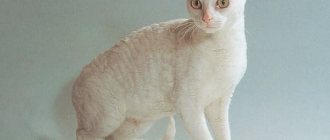The Savannah cat is a breed that is a cross between ordinary domestic cats and their wild relatives. Their appearance resembles a serval, but at the same time they have an affectionate nature. The popularity of this breed is just beginning to gain momentum. This is evidenced by a threefold increase in demand for them in the period from 2021 to 2019.
History of the Savannah breed
Savannah cat
The first experiment on crossing an African serval with a Siamese cat took place in 1986, on the farm of Pennsylvania breeder Judy Frank. The woman had been breeding bush cats for quite some time, so in order to “refresh the blood” of her pets a little, she borrowed a male serval from her friend Susie Woods. The animal successfully completed the task, but the unexpected happened: along with the females of its species, the serval managed to cover the breeder’s domestic cat.
The owner of the only female kitten born as a result of this unusual “love affair” was Susie Woods. It was she who gave the animal the nickname Savannah, which later became the name of the breed of new hybrid cats. By the way, Susie herself was not a professional breeder, which did not stop her from further experimenting with mating her pet with a domestic cat and publishing a couple of articles on this topic.
The main contribution to the development of the Savannah breed was made by Patrick Kelly, who bought a kitten from Susie Woods and attracted an experienced breeder and Bengal breeder, Joyce Sroufe, to breed new cats. Already in 1996, Kelly and Sroufe introduced TICA (International Cat Association) new unusual cheetah-colored animals. They also developed the first standard for the appearance of savannahs.
In 2001, the breed was officially registered and finally received recognition from the largest felinological associations, and breeder Joyce Sroufe gained worldwide fame as the founder of an elite cat “clan”.
Breed standards
| Breed name: | Savannah |
| Alternative title: | Savannah |
| Country of origin: | USA |
| Breed size: | Large |
| Breed group: | Long-legged |
| Average weight: | Cat: up to 14 kg Cat: up to 9 kg |
| Color standards: | Silver tabby Chocolate tabby Golden tabby |
| Coat type: | Shorthair Smoothhair |
| Character and personality: | Unpredictable Wild Smart Intelligent Curious Independent |
| Lifespan: | 17 – 20 years |
| TICA standards: |
Who are ushers
Ashera cats are purely an advertising product and have not yet been recognized by any felinological association. In 2007, the American cat presented to the world giant leopard cats, which were allegedly born as a result of complex genetic experiments. According to the owner of the company, Simon Brody, the domestic cat, the African serval and the Asian leopard cat donated their genes to the new breed. Well, the main selling legend of Asher was their complete hypoallergenicity.
African serval in the wild
To give buyers confidence in the exclusivity of his product, Brody even paid for a scientific study that was supposed to confirm the hypothesis that Asscher wool contains a minimal amount of allergens. By the way, the results of the experiment were never published by any self-respecting publication, and in general they turned out to be fictitious, but at the very beginning of the popularization of the breed, these pseudoscientific research made good advertising for cats. A line of wealthy breeders and exotic lovers immediately lined up behind the ushers, who took their money to “Lifestyle Pets” in the hope of becoming the owner of an amazing animal.
The general euphoria did not last long. The myth about unique image cats bred in the secret laboratories of Lifestyle Pets was dispelled by Pennsylvania breeder Chris Shirk. The breeder made a statement that company employees purchased several Savannah cats from him, after which they presented them as a completely new species. The hype around the Asher flared up with renewed vigor, and as a result, independent geneticists in the Netherlands took up the work of the furry creatures.
The result of the research was stunning: all the animals purchased from Lifestyle Pets agents were indeed Savannah breeds. Moreover, VIP cats turned out to be carriers of the same number of allergens as their outbred relatives. Irrefutable evidence of deception on the part of Lifestyle Pets and Simon Brody was the beginning of the end for the non-existent breed, but did not in any way affect the popularity of the Savannahs themselves.
The name “asherah” is borrowed from Western Semitic mythology and is consonant with the name of the goddess, personifying the natural principle.
Character of the breed
Cats are easy to train. Teams from the category “Barsik, it’s time to eat!” have nothing to do with them. Savannah will easily show aggression towards a stranger, attack the enemy and even bring slippers. Yes, these cats are smart and resourceful. But the affectionate behavior characteristic of domestic relatives is rarely manifested.
So, if a first-generation Savannah kitten is affectionate and docile in early childhood, then by the age of three there is a likelihood of aggressive behavior. By the age of three, a cat’s personal qualities are finally formed. Therefore, they should be kept in a spacious enclosure.
As for the other cats, their character is rather docile and balanced. Savannah is sociable. The cat has leadership qualities. If there are other pets living in the house, then Savannah will certainly take the position of leader and lead the “pack”. By the way, these cats have a special relationship with dogs due to their similar characters.
Activity
The breed is characterized by excessive energy and curiosity. Savannahs study the higher surfaces with great interest. These are playful natures who prefer outdoor games and a lot of free space. Savannahs love walks in the fresh air: in parks where you can climb a tree. Therefore, it is advisable to walk such cats on a leash.
Jumping is everything. Adults can easily overcome a height of 2.5 meters. At home, Savannah will find a place on the refrigerator or cabinet. Their inherent curiosity, activity and playfulness awakens a passion for adventure in cats of this breed. Exploring new places, exploring inaccessible spaces is a favorite pastime. They will certainly find out why the cabinet or refrigerator door does not open. Therefore, Savannah owners should take this into account to prevent their pet from accidentally causing mischief.
Social adaptation
This breed easily gets along with other pets, children and family friends. But this rule cannot be applied to all representatives - some cats can behave aggressively towards other animals and strangers. Savannah runs away, hisses menacingly and hides at the sight of a stranger.
There are cases when Savannahs, as they grew older, took the position of leader among other pets and confidently maintained this position.
An interesting feature of the breed is its love of water. Cats take great pleasure in water treatments and play in this environment. They dive into deep containers of water. On a walk near a pond, a cat can easily jump into the water and swim with pleasure. The owner can take the animal with him to the shower or bath - Savannah will not deny himself the pleasure of refreshing himself.
Place an ordinary basin with water - the cat will certainly start rinsing its paws in it. A favorite game is throwing toys into the bath, which you can then take out. This interesting feature has a genetic predisposition. Savannah's closest ancestors, the servals, prefer to hunt near bodies of water.
Savannah appearance
Savannah kitten
Savannahs are large creatures: the animal’s body length can reach up to 1 m, and its weight can reach 14 kg. There is no standard of appearance for Asheras, since modern felinological associations refuse to recognize them as an independent breed. Accordingly, in order to establish that an animal belongs to the Asher clan, today's breeders have to use the standard that was approved at one time for the savannah.
Head
Small, wedge-shaped, noticeably extended forward. Cheeks and cheekbones do not stand out. The transition from the muzzle to the forehead is almost straight.
Nose
The bridge of the nose is wide, the nose and earlobe are large and convex. In black animals, the color of the nose coincides with the shade of the coat. In tabby-colored individuals, the lobe can be red, brown and black with a pinkish-red line in the central part.
Eyes
Savannah's eyes are large, set obliquely and moderately deep, with almond-shaped lower eyelids. There are tear-shaped marks in the corners of the eyes. The shades of the iris do not depend on the color of the animal and can vary from golden to rich green.
Ears
Large, with a deep funnel, set high. The distance between the ears is minimal, the tip of the auricle is rounded. The inside of the funnel is pubescent, but the hair in this area is short and does not protrude beyond the boundaries of the ear. It is desirable to have light markings on the outside of the ear funnel.
Neck
Graceful, moderately wide and long.
Savannah muzzle
Body
The Savannah's body is athletic, graceful, with an excellently developed muscle corset. The chest is wide. The pelvic area is significantly narrower than the shoulder area.
Limbs
Savannah cat
Muscular and very long. The hips and shoulders are elongated with well-developed muscles. The paws are oval, the front ones are noticeably shorter than the hind ones. The fingers are massive, the claws are large and hard.
Tail
The Savannah's tail is of medium thickness and length, tapering slightly from base to tip and reaching the hock. Ideally, it should have a bright color.
Wool
Short or medium length. The undercoat is soft but dense. The guard hair is hard, coarse, and in the areas where the spotted “print” is located it has a softer structure.
Color
There are four main colors of the Savannah: brown tabby spotted, black smoky, black and silver spotted. The standard shade of spots is from dark brown to black. The shape of the spots is oval, slightly elongated, the outline is clear and graphic. The spots on the chest, legs and head are smaller than on the back. It is necessary to have parallel contrasting stripes in the direction from the back of the head to the shoulder blades.
Since Savannahs are a hybrid breed, the external characteristics of individuals directly depend on which generation the animal belongs to. For example, F1 hybrids are larger and very similar to servals. Representatives of the second generation are noticeably smaller, since they received only 29% of the blood of the wild ancestor.
Savannah/Asher hybrid progeny levels
- F1 - individuals born as a result of crossing an African serval and a domestic cat, combining an equal ratio of “wild” and “domestic” genes.
- F2 – offspring obtained from an F1 cat and a domestic cat.
- F3 – kittens born from an F2 female and a male domestic cat. The percentage of serval genes in representatives of this generation is about 13%.
- F4, F5 – individuals born as a result of mating of a hybrid F3 and a regular cat. Kittens of this generation are not much different from ordinary domestic cats. The wild essence in them is revealed only by their leopard coloring and some “oddities” of character typical of savannahs.
Main disqualifying faults of the breed
Savannahs are more often disqualified for misconduct than for birth defects. Individuals with color defects, in particular with rosette spots, “medallions” in the chest area and small ears, are subject to mandatory fines. Polydacts (cats with extra toes on their paws), animals trying to bite a person approaching them, or, conversely, savannas who are too cowardly and do not make contact are completely disqualified.
Savannah F1
Savannah F4
Breeding
To breed the most beautiful and expensive cats, they use a female serval and a domestic cat (most often a Bengal or Siamese breed). At the same time, it is very difficult to wait for a wild predator and a domestic pet to mate. To increase the likelihood of mating, they are raised together for a long time so that the animals get used to each other. The survival rate of kittens is very low - no more than 15%.
Due to the fact that the male offspring born are sterile up to the fourth generation, further breeding is carried out exclusively by mating a Savannah cat and a domestic cat of another breed. In this case, the cost of the animal decreases.
Those who decide to get a Savannah cat should keep in mind that along with the acquisition of a beautiful exotic animal, the owner is entrusted with additional worries due to the obstinate nature of the pet. You should not take it if the family has a small child or there is no financial opportunity to buy expensive, high-quality food.
Savannah/Ushera cat personality
According to the PR people from Lifestyle Pets, the genes of the aggressive African serval never awaken in Ashers. However, such statements are more like beautiful advertising than reality. Of course, representatives of this breed are quite friendly pets, but they will never become “sofa cushions”. In addition, they are extremely intelligent and active, so they are unlikely to be suitable for people who consider the animal as a living interior decoration.
Savannah kitten with baby
The passion for dominance, inherited by Savannah Ashers from a wild ancestor, is successfully extinguished by castration or sterilization of the pet, after which the animal’s character undergoes significant changes. The cat becomes calmer and more tolerant of external stimuli, although it does not completely abandon its leadership habits. Individuals of the first and second generations are especially guilty of this, so it is better to take F3-F4 hybrids for families with children.
Representatives of the Savannah clan absolutely cannot stand loneliness, so do not leave the animal alone for a long time in an empty house. Unless, of course, you are not afraid of the prospect of returning to a trashed home with scratched furniture. Most individuals have rancor, so you should treat savannahs with respect.
F1 individuals perceive strangers who enter their territory quite negatively, which they warn about with loud aggressive hissing and grumbling. With each subsequent generation of cats, the wariness becomes less pronounced, although in general the Savannah cats do not favor strangers. In relationships with the owner, the genes of the African serval are not so pronounced, but otherwise the same principle applies here as in the case of strangers: in order to be able to pet the pet, you should choose at least an F4 hybrid. Savannahs/Ushers are cats of one owner. You should not expect that your “pet cheetah” will love and obey every family member equally. However, he will not fight with them either; rather, he will demonstrate complete indifference.
Savannah F5
Breed characteristics
| Activity and energy: | Read more Requires constant physical and mental stress |
| Ease of care: | Read more Savannah is independent and takes good care of its coat and hygiene. The owner’s task is to monitor the cat’s health |
| Child Friendly: | Read more Gets along well and loves to play with children. However, this is not a breed that should be recommended to families with children. Still, the Savannah is a wild cat than a domestic cat (especially F1) |
| Friendliness to other animals: | Read more Gets along well with all pets if taught to live together from an early age |
| Shedding level: | More details Minimum |
| Meow: | Savannah does not bother her owners with her meowing for no reason |
Education and training
Since Savannahs need to be walked to maintain health and muscle tone, it is worthwhile to accustom the animal to walking on a leash in advance. F1 hybrids are the most difficult to train, as they are still half serval. It is better to keep such animals in a country house, in a special enclosure. When it comes to training, cats of this breed are smart enough to master techniques designed for dogs. In particular, Savannahs love the command “Fetch!” most of all.
Savannahs are natural hunters, so they can sometimes hone their tactical skills on their owner. It is better to wean a kitten from this harmful, and also dangerous for humans, habit by regular games in the fresh air and by buying toys for your pet in the form of mice and other small animals.
How to choose a savannah, where to buy and how much to have with you
If, after studying all the nuances of the breed, you still decide to buy such a pet, then the first thing you should do is decide on a nursery. Savannah owners usually do not breed this breed on their own, leaving it to professionals. You should choose a well-known and trusted cattery, study the reviews of specialists and breed experts about their cats, and you can go choose a kitten. It is best to involve a veterinarian in this process. He will be able to visually identify a strong and healthy baby. You can choose a kitten only after it reaches three months of age, but you can take it home only after two months. By the age of five months, the kitten will be vaccinated and ready to be transported to a new home.
Considering the difficulties in breeding cats of this breed, the cost of kittens varies from 4 to 22 thousand US dollars. Females of the F1 and F2 generations are especially valued. Males of the first 4 generations are sterile, so their price is significantly lower.
Criteria for assessing a kitten
When purchasing a Savannah kitten, you should pay attention to the following important points:
- Appearance of the kitten’s parents: their size, distinctive features of the breed (eyes, ears, “wild marks”, color, color of spots, etc.).
- Pedigree: crossing closely related individuals is not allowed, as their offspring quickly die for no apparent reason.
- Conditions of keeping: cats should not sit in cramped cages; conditions should be comfortable for parents and offspring.
- All animals should be friendly, well-fed, playful and easy to get along with.
- If the baby is aggressive, hisses and attacks, it is likely that in the future he will not become a cute and affectionate kitten.
- The contract under which you purchase an expensive pet must ensure that the baby is tested for infections and vaccinated.
Soon a chic, graceful exotic cat will grow from a fluffy ball
Nurseries
There are few nurseries that offer Savannah kittens. The nursery organized by Joyce Sroufe “A1 SAVANNAHS” in the USA is still considered the best in terms of the quality of the gene pool of this breed. There are several nurseries in Russia where you can purchase savannah:
- "L'unicorne" in Moscow;
- "Savannah Premium" in St. Petersburg;
- "Royal Cats" in Kyiv;
- "Luxury Cats" in Kyiv.
Care and maintenance
Walking a lot and often, paying maximum attention, putting up with the inevitable destruction in the home and the independence of the pet’s character - this is a short list of rules that the owner of the savannah will have to obey. Since representatives of this breed have extraordinary jumping ability, it is worth thinking thoroughly about the interior design of the house, otherwise all the vases and figurines will be swept off the shelves every day. In addition, like Maine Coons, Savannahs love to create viewing platforms for themselves on cabinets and other furniture modules. This addiction can be treated by purchasing and laying out an electric mat on surfaces on which the pet is planned to be weaned from lying on.
Looks out for prey
You can’t do without scratching posts when raising a savannah, but when purchasing them, you should take into account the size of the animal. Small and flimsy products designed for regular cats will not last long. Before you get a cheetah kitten, make sure you have the right trash cans. They should have tight-fitting lids because Savannahs are very curious and love to check trash containers for cat treasures.
Savannah fur care is minimal. Usually the animal is combed once a week, although during the molting period it is recommended to do this procedure daily. However, some breeders advise replacing classic combing by wiping your pet’s fur with an ordinary damp cloth. Savannahs, as a rule, do not require the services of a groomer. Cat's claws need to be trimmed regularly. Overly wayward individuals undergo laser onychectomy (removal of claws on the front paws). Bathe the animal as needed. By the way, Savannah Ashers respect water procedures and enjoy swimming in baths and pools as soon as the right opportunity presents itself.
Representatives of this breed do not have any difficulties with the toilet. For hybrids F4 and F5, which are characterized by relatively small sizes, a classic tray is suitable, although most individuals easily get used to an outdoor toilet. In addition, Savannahs are able to master the intricacies of using the toilet. Accordingly, if you want to save yourself the hassle of cleaning the litter box, try teaching your pet this wisdom.
Savannah (Asherah)
Description of the breed
The Savannah cat is similar to the cheetah and the African serval. These are extremely active, intelligent and graceful animals, so connoisseurs are ready to purchase them for large sums. They require a lot of space because... These pets love to jump and run. In addition, they are not afraid of water and are excellent swimmers.
Representatives of this breed can be distinguished from Bengal cats by their coat and body size. Bengals are smaller and come in a variety of colors including charcoal, blue, spotted, snow, etc. Savannah has a spotted undercoat. The spots in almost all cases are black or brownish in color.
Savannah cat standards suggest the following characteristics:
- muscular, elongated body;
- massive breasts;
- elongated neck;
- the paws are longer in the back than in the front;
- pads are brown or black;
- the head is small in size;
- wide nose;
- eyes yellow or copper;
- ears are rounded and large;
- The coat is short and thick, with coarse hairs.
The height of the animal at the withers can reach 60 cm, and the length is about 135 cm. Body weight depends on gender and ranges from 7 to 15 kg.
Feeding
And a shrimp for me!
The savannah menu should to some extent copy the daily “table” of the serval. The most win-win option is to feed your pet high-quality meat (can be raw). Savannahs are especially recommended to eat lean meat, in particular rabbit, veal and chicken. Fish, unless it is tuna or salmon, is best avoided altogether, as is milk. Experienced breeders claim that it will be difficult for the animal to live alone, so it is worth choosing a vitamin complex from the veterinarian in advance, which includes taurine, which helps normalize the cat’s cardiac activity. Dry feeding also has its place, but it should be taken into account that these should be premium varieties of feed containing a minimum percentage of cereals.
Health (characteristic diseases and life expectancy)
The breed is distinguished by good health and stable immunity.
However, poor nutrition, lack of fresh air and an active lifestyle lead to the development of typical cat diseases:
- Heart diseases. Veterinarians often diagnose hypertrophic cardiomyopathy.
- Parasitic diseases and urinary tract infections.
- Respiratory diseases.
- Gynecological diseases in nulliparous females.
When to contact a veterinarian? When your pet’s condition is in doubt or there is fear for the animal’s life. Prolonged refusal to eat, irregular bowel movements, discharge or unpleasant odor (from the ears, eyes, nose, genitals), hair loss, elevated body temperature and apathy - even one such sign is a reason to consult a doctor.
Vaccination and deworming will eliminate the likelihood of unpleasant consequences. The veterinarian sets out the vaccination schedule individually. Most often, cats are given injections against rabies, rhinotracheitis, runny nose, and epizootics. The first vaccine is at two months. Every year the kitten is vaccinated against ringworm and chlamydia.
Males of the first four generations are infertile. The offspring produces only F5. Proper care, attention and care, necessary living conditions - all this will lead to Savannah living for at least 15 years next to its owner.
Mating
All male savannahs, from the F1 generation to the F4 generation, are sterile. However, such individuals are subject to castration.
F5 males are capable of reproducing offspring, so they can be bred with other domestic cats. In particular, breeders allow the possibility of mating the fifth generation Savannah with such breeds as the Bengal cat, Ocicat, Egyptian Mau, as well as ordinary mongrel cats.
Individuals who have reached the age of 1.5-2 years are considered sexually mature and capable of producing healthy offspring.
Advantages and disadvantages
Savannah cats are exotic animals that require special treatment. Therefore, before getting a pet, you need to weigh the main pros and cons.
Pros:
- Looks like a graceful wild cat, but is suitable for living in a domestic environment.
- Affectionate, sociable with people and animals.
- Very smart and trainable.
- Loves to swim.
Minuses:
- In some places, ownership of Savannah cats is prohibited.
- The breed is rare and expensive.
- Prone to hypertrophic cardiomyopathy.
- A special diet may be required.
Savannah/Ushera Health and Diseases
Despite their “artificiality,” representatives of the Savannah/Asher family have excellent health and are able to live up to 20 years. A few birth defects observed in kittens of this breed include: polydactyly, hydrocephalus, dwarfism and cleft palate. In some cases, animals may be susceptible to bacterial, viral or fungal infections. You can tell if your cat is sick by changes in behavior. Lethargy, excessive shedding, decreased appetite, vomiting and too frequent urination signal that the pet’s body has malfunctioned.
Owner reviews
We got ourselves an exotic Savannah cat F5. I didn’t even expect that her behavior would be so different from an ordinary cat. By the way, she got along very well with a dog that is older than her. In principle, there are no problems, except for one: I don’t know how to go on vacation now, the cat is very attached to me, and because of the long separation, I’m afraid it will suffer.
Irina Kovaleva, Nizhny Novgorod
https://koti-koshki.ru/koshka-savanna.html
Yesterday our handsome Savannah breed arrived to us. The first time after transportation he was a little slow. Apparently, the road and stress took their toll. But what happened next! His reaction is simply lightning fast. He rushes through the house like a hurricane, sweeping away everything in his path. The downside is that he hunts me, and the kitten’s claws are rather big! I walk around all scratched up, I don’t have time to dodge. Kotinka is a born hunter, it’s immediately obvious that wild blood takes its toll! Almost immediately he created a place for himself in the house, built something like a nest. He carries his toys and food there. He looks very proud. In general, I’m happy so far, it’s clear that the animal is very smart. I definitely won’t be bored anytime soon!
Elena M, Moscow
https://koti-koshki.ru/koshka-savanna.html
I have been the mother of a Savannah boy for two years now. I want to say one thing: having such a pet at home is real happiness. He's so smart! We learned several commands with him, he gives me his paw. And how he likes to work out! When we go out for a walk, we invariably attract everyone's attention. Some people ask what kind of animal this is because they cannot understand that it is a cat.
Valentina, Moscow
https://koti-koshki.ru/koshka-savanna.html
Video: Savannah F1 from L'UNICORNE nursery
“We are responsible for those we have tamed,” is the famous phrase of Exupery. When accepting such a kitten into your family and life, remember that this is not only the admiring glances of others, but also a great responsibility. Especially when we are talking about exotic animals with admixtures of “wild” blood. For all their brutality and serious appearance, savannahs are gentle and devoted animals. They will happily return all the love and affection you give them. When such an independent animal rubs against your leg, you will feel like the master of the wild!
How to choose a kitten
As with other purebred kittens, before purchasing a Savannah/Usher, it is worth thoroughly researching nurseries that sell “pet cheetahs.” Information about the vaccinations the kitten received, living conditions, pedigree - all these points are included in the mandatory inspection program of the establishment.
The behavior of the animal should be friendly and adequate, so it is better to immediately abandon hissing and scratching kittens, unless your plans include purchasing F1 individuals, for which such displays of emotions are the norm. Most nurseries begin selling kittens that are 3-4 months old, who already know how to use a litter box and have received the necessary “package” of vaccinations. It is mandatory to test the animal for hidden infections.
Character
These cats have extremely interesting personalities. They are energetic, smart and quick-witted. Breeders note that the Savannah is similar in behavior to a dog. The animal is highly trainable and loves active recreation.
Representatives of the breed calmly adapt to new living conditions and often express gratitude and love to their owners. Due to their activity, they require a lot of free space, because the habits of the wild ancestor are still preserved in their character. Savannah cats love water, so owners often arrange water games for them.
Savannahs get along well with people and other animals. However, in some cases they become tiring, because... are constantly looking for entertainment. Most often they occupy a dominant role in the home.
These cats do not cause any problems in the house. They constantly follow their owner and wait for his return near the front door. This character trait sometimes causes inconvenience. For example, if you are away for a long time, you will have to take the animal with you.
Photos of Savannah kittens
Features of feeding
Feeding a pet is a serious matter that needs to be given due attention. When choosing a Savannah kitten, ask the breeder what to feed the animal and how many times a day. A young cat is fed 5-6 times a day, an adult cat - 3 times a day. Three month old kittens eat almost everything. Cereal or vegetable porridges, minced meat, dairy products, cheeses, cottage cheese, kefir, sour cream - each new product should be introduced gradually. From four months, the Savannah kitten is ready to eat ready-made food: first wet, then soaked in water, then dry.
At six months the cat calmly eats regular adult food. At this point, it is important to know what type of food you plan to feed your pet (ready-made food or homemade food). Each of them has advantages and disadvantages. Focus on the financial side of the issue and the amount of free time.
An adult cat is fed natural food.
The diet includes the following products:
- Fresh meat (cooked or raw): offal, minced chicken, beef or pork, boneless fish.
- Vegetables and fruits (boiled and raw).
- Cereal porridge.
- Sprouted wheat.
- Yeast, vitamins and minerals.
You should not give your cat fatty meat, chicken and fish bones, or river fish. As for dry food, premium is preferable.
How much does savannah cost?
In the first months after the announcement of the breed, businessmen from “Lifestyle Pets” managed to sell Ashers for 22,000 - 26,000 dollars per individual, which at that time was an exorbitant amount. Moreover, in order to get a VIP pet, you literally had to wait in line. After Simon Brody's scam was revealed and the Ashers "transformed" into Savannahs, their price dropped slightly, but not so much that cats began to be bought up. Today you can buy a Savannah/Ushera kitten for 500,000 - 1,000,000 rubles. The most expensive are the F1 hybrids, which are distinguished by their impressive dimensions and have a bright “wild” appearance. In the fifth generation of animals, the highest price tag is placed on male individuals, which is due to their ability to reproduce offspring.
Savannah breeding
It is believed that sexual maturity in savannas occurs at 7–9 months. But it is better to breed a cat with a cat after she is one year old. A cat must be strong and healthy in order to bear and give birth to babies without harm to itself and its offspring.
Mating
Mating of this breed is carried out only under the supervision of nursery specialists.
According to the rules of most clubs, before mating, a cat must receive a “breeding assessment” at an exhibition. Breeding of cats with a rating of at least “Very Good” is allowed, and cats with Breed Champion titles and above may not attend exhibitions before mating. According to the rules, cats should not give birth to kittens more than three times every two years. Before mating, the cat must be vaccinated against the main infectious diseases: rhinotracheitis, rabies, calicivirus infection and panleukopenia (included in the complex vaccination), + against chlamydia and lichen. And this should be stamped in the veterinary passport. No more than one year and no less than one month should pass from the time of vaccination to mating. The cat must be dewormed 7 days before breeding.
https://savannahpremium.com/art4.html
For mating, the cat is usually taken to the cat, and not vice versa. Before the planned “wedding”, the lady needs to get her nails done so that she does not injure the cat with her sharp claws during mating games. The newlyweds may need from 1 to 3 days, depending on the groom’s activity. After the cat is fertilized, she loses the scent that attracts the male, and he loses interest in her. A cat's pregnancy lasts 9 weeks. A few days before giving birth, she changes in behavior: she follows on the heels of her owner, her temperature drops. Get ready: there will be a new addition to the family soon. Stock up in advance with the phone number of a veterinarian who you can call in the middle of the night; you may need qualified specialist help.
Savannah breeding is carried out under the supervision of a nursery specialist and veterinarian
Sterilization
If you decide that you do not want to engage in Savannah breeding, then at the age of 5-6 months the animal should be castrated or sterilized. Pets will not mark territory and become nervous due to the absence of a partner. In the USA, early castration of animals is now popular: before 6 weeks of age. Veterinarians believe that the recovery period at an early age is faster and easier for the pet to tolerate.
Appearance
According to established standards, these cats have a flexible, slender, elongated body. The cat looks heavier than it actually is. It stands out for its very large, rounded ears. Limbs are long and strong. The hind legs are longer than the front legs, like those of large cats. The tail is long and straight. The short fur of a Savannah kitten is very soft and thick. The undercoat is soft, dense, evenly distributed throughout the body. Another feature is that the paws are round, small in size, and colored charcoal or dark brown. Savannah is distinguished by its noble posture and natural grace. Unlike the British, who are considered to be such “bumps” in the cat world.
Standard colors: cinnamon tabby, chocolate, gold-silver, brown.
The largest representative of domestic cats. Height at the withers is up to 60 cm, weight is 13-15 kg. They reach their maximum size at 3 years. Savannahs live for about 15 years.
What is the difference between a Savannah and a Bengal cat?
Despite the similarities in appearance, the Savannah cat and the Bengal cat have a number of significant differences.
- The pedigree of Bengal cats originates from the Far Eastern cats, and in the savannas - from African servals.
- If you look closely at Savannahs and Bengals, differences in the coloring of the skin are visible to the naked eye. In Bengals it is dotted with dark spots of three different colors. Savannahs have spots of the same tone.
- Distinctive features are manifested in the structure of the body. The Bengal breed has a compact body, like an American football player. These are cats with small ears and large round eyes. But Savannah is compared to a tall basketball player. They have big ears.

